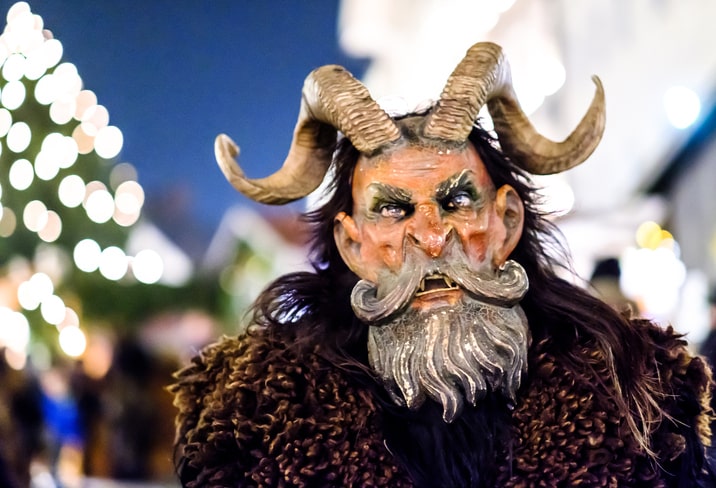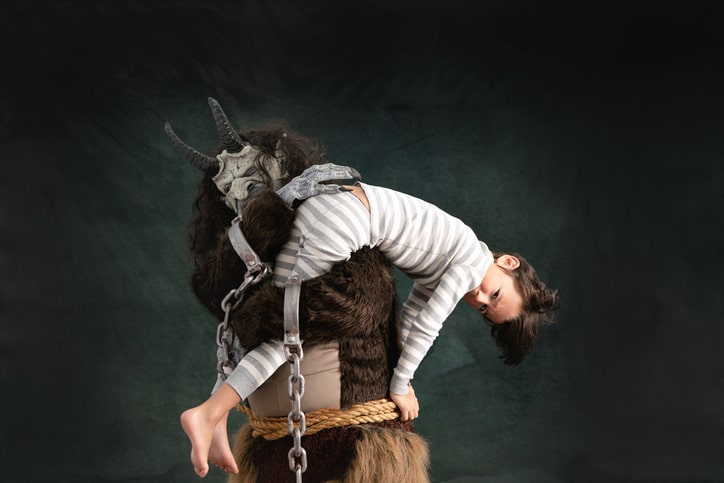Krampus: The Christmas Devil


In the realm of holiday folklore, few figures are as intriguing and fearsome as Krampus, the Christmas devil. With his long horns, cloven hooves, and menacing appearance, Krampus is a legendary creature that has captured the imaginations of people around the world. This Austrian and German Christmas tradition provides a stark contrast to the jolly figure of Santa Claus known to American and English children. In this article, we will delve into the origins, traditions, and cultural significance of Krampus, exploring the darker side of Christmas traditions.
Origins and Legends of Krampus
Krampus is thought to have roots dating back to pre-Christian Alpine traditions. In folklore, Krampus accompanies St. Nicholas (Sankt Nikolaus in German) during the Christmas season, acting as his demonic counterpart. Let’s uncover some of the most interesting aspects of Krampus and his cultural history.
Ancient Roots
The mythology of Krampus traces back to ancient pagan traditions in Europe, particularly in Germanic and Alpine regions. The name "Krampus" is derived from the German word "Krampen," which means "claw." It is believed that Krampus predates Christianity and was originally associated with winter solstice celebrations, similar to the Norse pagan traditions hel. Unfolding alongside the saintly narrative of St. Nicholas, Krampus represents an intriguing duality to the Christian holiday season.
The Companion of St. Nicholas
In popular folklore, Krampus is often depicted as the counterpart to St. Nicholas, the benevolent gift-giver seen throughout Europe and America. While St. Nicholas rewards well-behaved children with presents, Krampus is said to punish those who have been naughty. This half-goat, half-demon figure provides a balance between rewards and consequences during the Christmas season. On St. Nicholas Day, known as St. Nick’s Day, this duality is particularly manifest.
Krampus: A Terrifying Figure
Described as a demonic creature, Krampus is known for his terrifying appearance. He is typically depicted as a horned creature with a bestial face, a long tongue, and sharp fangs. His body, likened to the Christian devil, is covered in shaggy black fur, and he carries chains and a bundle of birch branches, or birch sticks, which he uses to scare and punish bad children. The sound of his chains and the swishing of the branches are said to strike fear into the hearts of misbehaving kids.

Traditions and Celebrations of Krampus
In many countries, Krampus is celebrated on St. Nicholas Day, December 6. Villagers dress up in costumes and roam the streets, beating drums or cowbells and shaking rattles to frighten naughty children. The celebration lasts all night, with people offering food and drinks to their visitors in exchange for presents. In some places, like Austria, people even have parades honoring Krampus.
Krampus has also become popular in the United States, with many cities hosting holiday parades and parties celebrating his mischievous nature. Krampus-themed merchandise like movies, books, costumes, and cards have been created to help spread the holiday merriment. The popularity of Krampus is on the rise all over the world as people
What Is Krampusnacht?
One of the most prominent Krampus traditions is the celebration of Krampusnacht, or Krampus Night. This event takes place on the evening of December 5th, the night before St. Nicholas' Day. During Krampusnacht, people dress up as Krampus and roam the streets, scaring onlookers and playfully punishing those who have been naughty. It is a festive and exhilarating occasion that has gained popularity in recent years, not just in the Alpine region but also in countries like Slovenia, Hungary, and the Czech Republic.
Krampus Parades and Festivals
In many European cities, Krampus parades and festivals have become highly anticipated annual events. Participants don elaborate Krampus costumes and masks, some of which are wooden masks used in the related Perchten tradition. The parades feature lively music, dancing, and theatrical performances, creating a unique and immersive experience for both locals and tourists.
Krampuslauf
Another notable tradition is the Krampuslauf, which translates to "Krampus run" in English. Participants in the Krampuslauf, often young men, dress up as Krampus and run through the streets, playfully chasing and scaring spectators. This tradition is believed to bring good luck and ward off evil spirits for the upcoming year.
Knecht Ruprecht
Knecht Ruprecht, also known as Farmhand Rupert or Servant Rupert, is a companion figure similar to Krampus in German folklore. He is often portrayed as a tall, bearded man dressed in tattered clothing and carrying a birch switch or a bag of ashes. Knecht Ruprecht is said to accompany St. Nicholas during his visits to children on December 6th, St. Nicholas' Day.
According to the legend, Knecht Ruprecht would ask children if they could pray, recite a poem, or answer questions about the Bible. Good children who passed the test would receive gifts from St. Nicholas, while naughty children would be lightly punished with a swat from Knecht Ruprecht's switch or a sprinkle of ashes.
Similar to Krampus, Knecht Ruprecht serves as a reminder of the consequences of misbehavior and the importance of being kind and obedient. Although not as widely known as Krampus, Knecht Ruprecht has his own unique place in the folklore and traditions of German-speaking regions during the Christmas season.

The Cultural Significance of Krampus
The cultural significance of Krampus has grown in recent years, as more people discover the lore behind this fascinating character. This is evident not only in celebrations but also in pop culture and the variety of audiences that enjoy the creepier side of Christmas — all thanks to Krampus.
Embracing the Dark Side of Christmas
Krampus represents the ancient folkloric belief that good and evil coexist in the world. By acknowledging the existence of Krampus, societies embrace the concept of balance and the consequences of one's actions. The legend of Krampus serves as a cautionary tale, reminding children and adults alike to be mindful of their behavior. Even the Catholic Church recognizes this figure as part of the holiday season narrative, adding an interesting dimension to the Christian celebration.
Preserving Tradition
In an era of commercialized and standardized celebrations, the tradition of Krampus stands out as a unique and cherished cultural heritage. Countries such as Austria, Germany, and parts of Eastern Europe have actively preserved and promoted Krampus traditions, ensuring that the folklore and customs surrounding this mythical creature endure for generations to come.
Krampus: the Pop Culture Phenomenon
In recent years, Krampus has gained significant attention in popular culture. From Germany to America, he has become a beloved and intriguing character in books, movies, and even holiday-themed merchandise.
In fact, the legend of Krampus has been brought to life on the big screen in the aptly titled film, "Krampus." Released in 2015, this horror-comedy movie directed by Michael Dougherty follows the story of a dysfunctional family who inadvertently summons the wrath of Krampus on Christmas Eve.
The film seamlessly blends elements of horror, dark humor, and holiday cheer. It showcases the menacing nature of Krampus as he terrorizes the family and their community, bringing a sense of dread and fear to the festive season. The movie skillfully captures the essence of Krampus folklore, delving into the darker side of Christmas and the consequences of losing the holiday spirit.
Additionally, this Halloween-esque celebration of Christmas appeals to those seeking alternative narratives and non-traditional holiday experiences. This resurgence is seen with the popularity of "Gruß vom Krampus" or "Greetings from Krampus" greeting cards during the holiday season. From New York to Washington, the Krampus tradition has found a place in American celebrations as well, alongside Santa and Saint Nicholas.
Creepy Christmas and Krampus
The legend of Krampus continues to fascinate and captivate people around the world, providing a unique and intriguing perspective on the holiday season. From ancient pagan roots to modern cultural significance, Krampus has evolved into a beloved tradition that celebrates balance, consequences, and the preservation of cultural heritage. This Christmas season, as you sit by the fireplace and sip on your hot cocoa, remember that Krampus may be lurking in the shadows, ready to remind us all of our actions. But don't worry; as long as you've been good this year, St. Nicholas will surely come with his presents instead.
So, this holiday season, embrace the shadowy side of Christmas and celebrate the legend of Krampus with a new perspective. Happy Krampusnacht! Or should we say, "Frohe Krampusnacht!"? The choice is yours. Plus, test your newfound knowledge and take our Krampus Quiz!
People Also Ask...
Do you still have questions regarding this terrifying Christmas demon? We have compiled some quick FAQs below that will clear up your queries about Krampus and the dark side of Christmas!
What Is Krampus?
Krampus is a folklore figure in Alpine countries who serves as a companion of St. Nicholas and symbolizes the consequences of misbehaving during the Christmas season. He is typically depicted as having a hairy, horned body, cloven hooves, and a long tongue.
When Is Krampusnacht?
Krampusnacht is celebrated annually on December 5th, the eve of St. Nicholas Day. It is a time for people to remember and embrace Krampus and his dark side of Christmas cheer.
What Is the Legend of Krampus?
The legend of Krampus dates back to Alpine countries in Central Europe, where it was said that misbehaving children would be punished by Krampus. He would carry away these children in his sack and take them to his underworld lair. It is said that in some cases, he would eat the naughty child!
What Do People Do on Krampusnacht?
On Krampusnacht, people celebrate with parades, parties, and events where they dress up as Krampus and parade around the streets. In addition, people will exchange gifts with each other, often mischievous items such as coal or switches instead of traditional presents. People also might hang Krampus decorations to ward away bad luck or evil spirits.
Who Is Krampus?
Krampus is a figure from European folklore who works with St. Nicholas to punish children who have been naughty. He is typically depicted as a horned, half-goat and half-demon creature who wears bells and carries chains and switches. He is said to roam the streets on Krampusnacht (December 5th) looking for misbehaving children to punish. He is also known as the “Black Peter” or “Knecht Ruprecht” in some areas of Europe.
About the author









